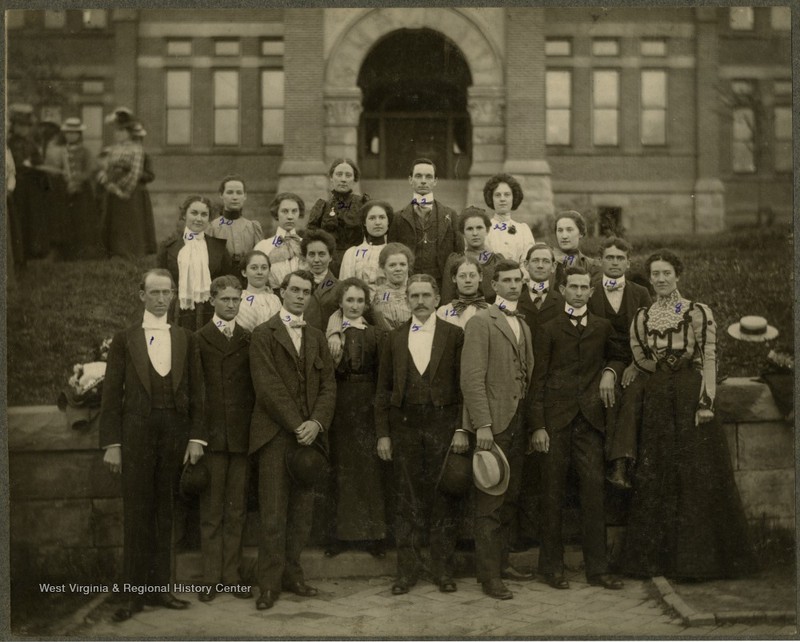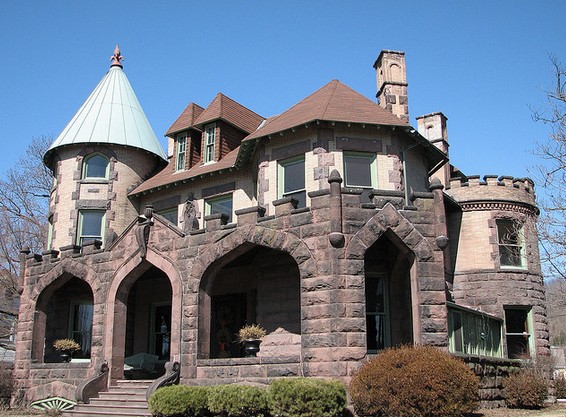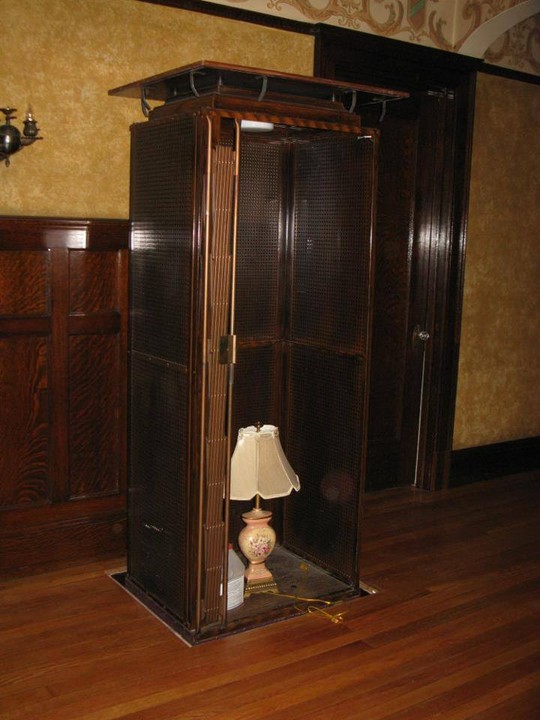Virgil Highland House
Introduction
Text-to-speech Audio
Images
Virgil Highland appears in the front left of this group of people in Fairmont, WV. Photograph from Ca. 1897-1898.

The Virgil Highland House.

A stained glass on the wall behind the staircase that leads to the second floor.


The elevator.

Backstory and Context
Text-to-speech Audio
The Highland family was one of Clarksburg’s first recorded settlers in 1802. In 1863, the State Legislature appointed commissioners to divide their counties into townships, name each township, and map out the decisions they had made and file them with the recorder of the county. The commissioners named in the act for Harrison County were Jacob Highland, Luther Haymond, Sidney Haymond, and John W. Boggess. The Union District was named by Jacob Highland in efforts to state his opposition to the secession of Virginia from the Union. John Edgar Highland attended the Northwest Academy in Clarksburg, and was a soldier for the Union Army during the Civil War. After moving to Weston for a short period of time, John Highland moved his family to the Highland homestead near West Milford in 1875. John and his wife Lucinda raised six children on the homestead, and all were influential in the development of Harrison County and the city of Clarksburg.
Virgil L. Highland worked on his father’s farm growing up, and went to school in the winter. Eventually he became a teacher, and attended college in Scio, Ohio with the money he had earned. Highland studied business and took courses in commercial work, penmanship, and banking. After graduating, Highland was employed by R.T. Lowndes, and in 1896 Highland was put in charge of the Lowndes interests which included the store, an electric light company, an artificial gas plant, a flour mill, and other businesses. Highland stayed in this position of power with Lowndes for seven years, and also served as the County Clerk of Harrison County from 1896-1902. Highland was also responsible for establishing or conducting other businesses in Clarksburg such as the Clarksburg Telegram Company, the Union Gas and Carbon Company, the West Chevy Chase Land Company, the Valley Coal and Coke Company, the Monongahela Valley Traction Company, the Elkhorn Coal Corporation, the West Virginia Metal Products Company, Merchants National Bank, the Southern States Mutual Life Insurance Company, the Hutchison Coal Company, the Clarksburg Lumber and Planning Mill, the Penfield Coal and Coke Company, the West Virginia Fair Association, and the Tuna Glass Company. Virgil Highland was locally known as Harrison County’s “Silent Man” for his dedication to politics and his work ethic.
Virgil Highland was highly instrumental in organizing the Empire National Bank in 1903, and served as the bank’s president from 1903 to 1930. After losing an election for circuit clerk in 1902, Highland set his sights on organizing a bank. The Empire National Bank opened its doors on October 3rd, 1903 in the Oak Hall Building. On February 14, 1907, the bank moved to the building for which it is now known. The Empire Building Company was established at the same time as the bank, and razed the Oliver Boughner General Store to construct the $100,000 Empire Building that was later purchased by the bank. The structure was seven stories high, and constructed of steel, brownstone, and brick. The bank’s main doors were bronze, while the interior was furnished with marble, bronze, and mahogany.
On November 12th, 1902, the Clarksburg Telegram appointed Virgil Highland, S.C. Denham, and C.W. Lynch to purchase the Clarksburg Daily Telegram and move the paper from a room on West Main Street to the Post publishing plant. They also changed the paper from a weekly publication to a daily publication, and installed a Sunday edition in 1914. The Telegram was printed in the basement of the Empire Bank Building, while the editorial offices were on Fourth Street.
The Virgil Highland House was built between 1903 and 1905 in a Victorian Romanesque style. At two and a half stories, the house appears larger due to the castle-like features. These include large cut stones, two towers, and a porch cornice designed to resemble a crenellated parapet. Tudor arches cap the windows, some of which contain richly colored stained glass panes. Clarksburg architects Holmboe and Lafferty were commissioned to design the building. Thanks to preservation efforts, the Virgil Highland House remains architecturally faithful to its original design. For example, a 2010 collaboration between building own Jennifer Lopez and The Mills Group restored the roof, skylights, and conservatory. Often known as the “castle house” by locals, the Virgil Highland House is a major contributor to the unique architecture and culture of Clarksburg.
Sources
Chambers, S Allen. Highland House, SAH Archipedia. January 1st 2012. Accessed March 30th 2021. https://sah-archipedia.org/buildings/WV-01-HR20.
Cork, Tim. Old Clarksburg Homes, Clarksburg My Home Town. Accessed March 30th 2021. http://clarksburg-myhometown.blogspot.com/p/homes.html.
Cornwell, Creel. Clarksburg: A Bicentennial 1785-1985. Clarksburg, WV. Clarksburg Bicentennial Committee, 1986.
Mills, Michael J. Highland Estate - Clarksburg, WV. Building Blocks. January 1st 2010.
Pederson, Ralph and Margo Stafford. Quality Hill Historic District, National Register of Historic Places. May 15th 1985. Accessed March 30th 2021. http://www.wvculture.org/shpo/nr/pdf/harrison/85001815.pdf.
“Group of People in Fairmont, W. Va.” Ca. 1897-1898. West Virginia & Regional History Center. Accessed March 30th 2021. https://wvhistoryonview.org/catalog/034580.
